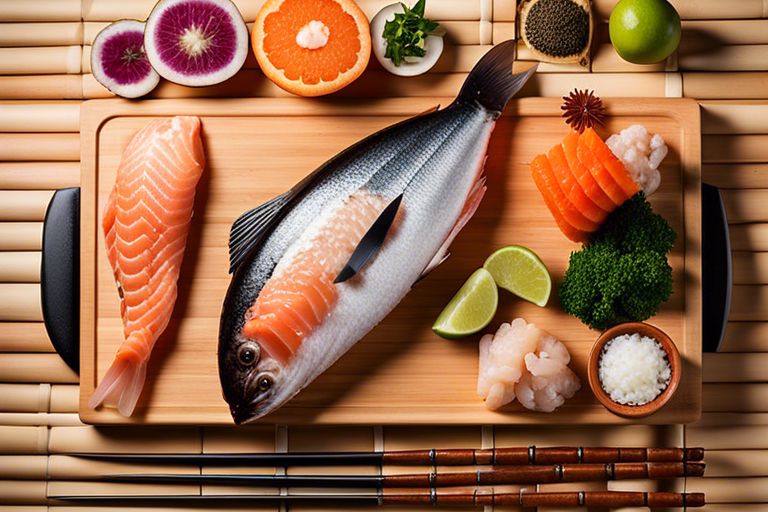Introduction
In this blog post, we will look at the important topic of freshness and quality criteria in seafood for the preparation of sushi. Sushi is a popular dish that has its origins in Japanese cuisine. The selection and texture of the seafood play a decisive role in the authentic taste and culinary experience.
Sushi – A Culinary Journey
However, before we dive into the details of the freshness and quality criteria of seafood for sushi, let’s first take a culinary journey through the world of sushi. It’s more than just raw fish on rice: sushi is an artful dish that is prepared with care and skill. The different types of sushi offer a variety of flavors and textures to discover.
Importance of freshness and quality in seafood
The freshness and quality of the seafood are vital to the sushi experience. Only high-quality and fresh ingredients can provide the authentic taste and delicate texture that make sushi so special. That is why it is essential to familiarize yourself with the quality criteria of seafood and understand what is important when choosing and preparing it.
When preparing sushi, it is important to pay attention to sustainable and responsible sources in order to protect marine resources and preserve the environment. Keywords: sushi, freshness, quality criteria, seafood, preparation, authentic taste, sustainable sources.
Recognising freshness
When buying seafood for sushi, it is important to recognize the freshness of the produce. This is the only way to guarantee the quality and taste of the sushi.
Visual characteristics of fresh seafood
Fresh seafood has clear, shiny eyes and a vibrant color. The skin should be moist and smooth. In addition, the scales should fit tightly and not come off easily.
The gills of fresh fish are bright red or pink, never gray or brown. Fresh crustaceans and mussels are tightly closed and do not open on their own.
Odor indicators for freshness
Another important indication of the freshness of seafood is the scent. Fresh seafood smells pleasantly of the sea and does not have a strong or putrid smell.
Therefore, it is advisable to use your nose and watch out for unpleasant odors before buying seafood for sushi. Because only fresh seafood makes for a delicious sushi experience.
Sushi Seafood Quality Standards
In the world of sushi, the quality of the seafood is crucial. The use of fresh and high-quality ingredients is essential to ensure the authentic taste and texture of the sushi. Therefore, it is important to familiarize yourself with the quality standards for sushi seafood in order to choose the best possible ingredients for preparing sushi.
Selection Criteria for Sushi Grade Fish
When choosing sushi-grade fish, there are several criteria that need to be considered. First of all, the freshness of the fish is of paramount importance. The fish should be fresh, with no signs of spoilage or foreign odor. In addition, the texture of the fish must be firm and elastic to ensure the best quality for preparing sushi.
Certifications and seals – what they tell us
Certifications and seals can provide valuable information about the origin and quality of seafood for sushi. For example, the MSC (Marine Stewardship Council) seal can indicate that the fish comes from sustainable sources. Other labels, such as the Aquaculture Stewardship Council (ASC) label, can indicate responsible aquaculture that takes into account environmental protection and social responsibility. By familiarizing ourselves with these certifications, we can make an informed decision when choosing sushi seafood.
Storage and pre-treatment
Proper storage and pre-treatment of seafood is crucial to the freshness and quality of sushi ingredients. Both when shopping and at home, care should be taken to ensure that the seafood is stored and pre-treated in optimal conditions to maintain its quality.
Proper Positioning Techniques
Seafood for sushi should always be stored in a cool place, ideally at a temperature between 0 and 4 degrees Celsius. Fish and seafood should also be stored in a well-ventilated area to avoid the formation of bacteria.
Pre-treatment to maintain quality
Before preparing sushi, the seafood should be rinsed thoroughly under cold water to remove any residue. In addition, it is important to process the seafood immediately after purchase or to pack it well and freeze it as quickly as possible in order to preserve its freshness and quality.
Pre-treating the seafood to maintain quality is a critical step in ensuring that the ingredients for sushi meet the highest quality standards. Through careful cleaning and quick storage, we can guarantee the freshness and taste of our sushi creations.
Frequently Asked Questions
If you’d like to learn more about the freshness and quality of seafood for sushi, visit our Freshness & Quality page.
Safe Consumption of Raw Seafood
When consuming raw seafood, it is important to pay attention to the freshness and quality of the products. Make sure that the seafood is always fresh and comes from trusted vendors. In addition, it is important that the products are properly stored and refrigerated to ensure safety when consumed.
Dealing with allergens and intolerances
People who suffer from allergies or intolerances should be especially careful when consuming seafood for sushi. It is important to check the ingredient list and, if necessary, ask the supplier about the allergens it contains. When buying and preparing foods, make sure that there is no cross-contamination with allergenic foods.
It is advisable to seek a thorough allergological consultation before consuming raw seafood in order to minimize any risks that may arise.
Closing Words
I hope this post has helped you better understand the freshness and quality criteria in seafood for sushi. Remember that you should always pay attention to the origin and freshness of the seafood to maximize your sushi experience. Enjoy your meal!
Summary of key points
In this post, we explored the importance of freshness and quality criteria in seafood for sushi. We have seen that the freshness of the ingredients has a huge impact on the taste and quality of the sushi. It is important to pay attention to the origin and choice of ingredients in order to enjoy a top-notch sushi experience.
The Art of Enjoying Sushi with Confidence
The art of enjoying sushi with confidence is to understand and appreciate the origin and freshness of the seafood. By consciously choosing high-quality ingredients and paying attention to where they come from, you can take your sushi experience to a new level.
FAQ
Q: What are the freshness and quality criteria for seafood used for sushi?
A: Seafood for sushi should be fresh and of high quality. They should be free of unpleasant odors and visible contaminants.
Q: How do I know if seafood is fresh for sushi?
A: Fresh seafood has clear, shiny eyes and firm, elastic flesh. They should also have a pleasant, neutral smell.
Q: What quality features should I look for when choosing seafood for sushi?
A: The seafood should be free of cuts, damage, or discoloration. The scales should be intact and the meat should appear firm and moist.
Q: How should I store seafood for sushi to preserve its freshness?
A: Seafood should be refrigerated and stored on ice until ready to use to preserve its freshness. They should not be packed airtight to avoid condensation.
Q: Are there any specific quality certifications I should look for in seafood for sushi?
A: Yes, when buying seafood for sushi, you should look for certifications such as MSC (Marine Stewardship Council) or ASC (Aquaculture Stewardship Council), which indicate sustainable fishing and aquaculture.


